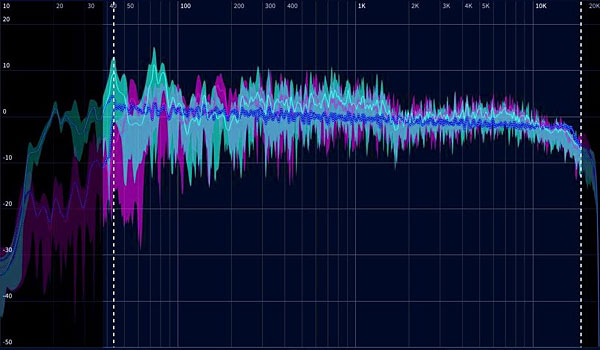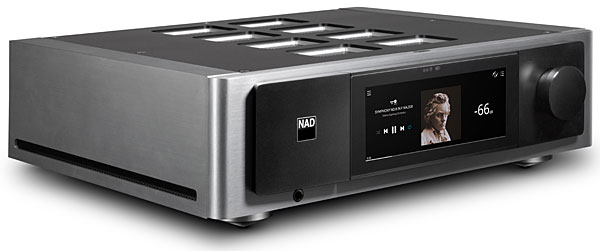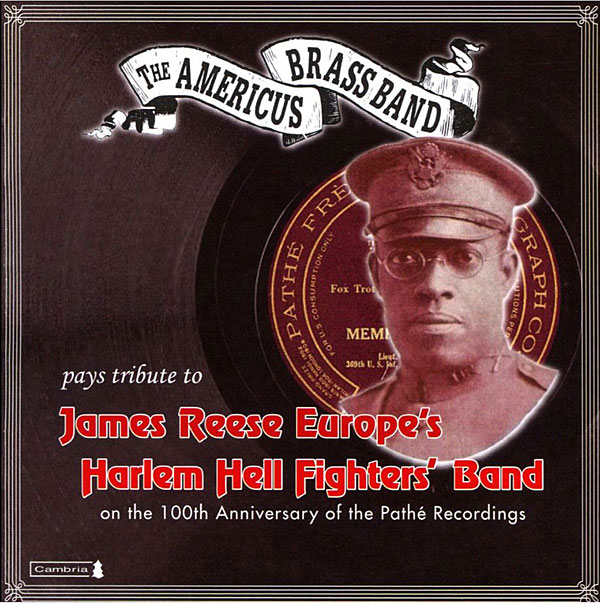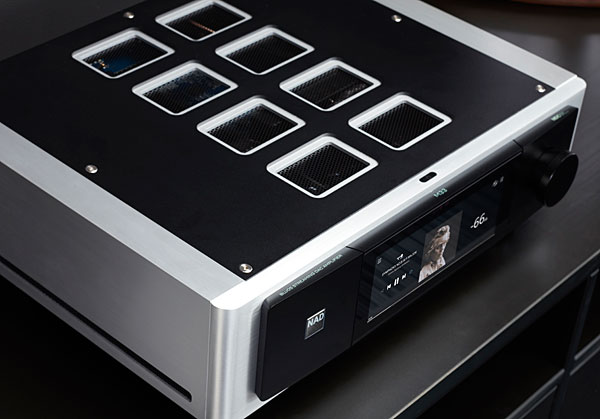| Columns Retired Columns & Blogs |
Hello John ,
I still Can’t wrap my head around how badly Class D amplifiers measure on square-waves , Thinking this must lead to why most hear odd timbre from them especially on difficult to drive loudspeakers ..

Things got even better when I added the three JL subwoofers, connected as one to the M33 with an 80Hz crossover and adjusted with Dirac Live 3 LE. The opening track on Pipes Rhode Island, John Dunstable's "Agincourt Hymn" played by Patrick Aiken (Riago 101), is remarkably clean and tight, with some distinct pedal notes of great power and definition. The M33 with Dirac and the subs let me play it at realistic levels with no taint of room modes to muddy it. And now the deep, shuddering tones of the synth bass on the eponymous track in Bela Fleck's Flight of the Cosmic Hippo (Warner Bros. 9 26562-2) were delineated as pitched, clear, musical notes. With "Jazz Variants," from the O-Zone Percussion Group's La Bamba (CD, Klavier KD 77017), it was as if my system had no dynamic limit at all. I annoyed my wife and neighbors for an entire afternoon, seeking the system's dynamic limits, only to find it was my own tolerance for loudness.
The improvements were even greater after I upgraded to the full version of Dirac Live, which can be unlocked in the M33 for $99.
I created several correction files with progressively higher upper frequency limits—500Hz, 1.6kHz, and 18.2kHz—and assigned them to different storage slots in the M33 so that I could select among them from the BluOS app on my iPad and assess their relative impact on the sound.
As I moved beyond the up-to-500Hz corrections permitted by the LE version to corrections with a higher upper-frequency limit, I perceived a subtle sharpening of the localization of voices and instruments in the acoustic space. A striking demonstration of this can be heard on Christian Euler's performance of solo viola pieces by Reger, Hindemith, Pochon, and Stravinsky (Viola Solo, MDG-Scene 903 2160-6, SACD). At first hearing, with the <500Hz correction, the instrument is clean and warm in a moderately reverberant space: the Benedictine Abbey in Marienmünster. Switching in the <1.6kHz correction, the viola seemed just a bit more precisely defined. With the effectively full-range correction (<18.2kHz), the Abbey walls stood aside, separating themselves from the instrument. There was no tonal shift, and the instrument was still right where it had been, but I had the impression that I was not hearing my room anymore.

What about Purifi?
As impressive as the M33 is for a single component of modest dimensions, the inclusion of the Purifi Eigentakt modules is an indication of NAD's aim to compete with traditional multicomponent systems. This is what spurred my interest in the M33, and in all my auditions, I never felt limited by the amps. Still, I am obligated to compare them with other power amps.
With a component like the M33, which digitizes its analog inputs, it's not possible to make an apples-to-apples comparison with conventional analog amplifiers; there will always be an extra round of A/D/A conversions inside the M33. Still, it's the sound produced that matters, so onward.
I used my reference digital front end as a source, switching among the analog inputs of the various amplifiers, including the M33. For the comparisons, I used the Studio2s full-range because inclusion of the subwoofers would have greatly complicated level matching. Of course, since my goal was to compare amplifiers, I turned off Dirac Live. Using pink-noise levels measured at the speaker terminals, I adjusted the sources from Roon so that all settings in the M33 were identical for the two amps. Managing the amp swap involved muting the M33, switching the cables at the speakers, resetting the volume in the source, and unmuting the M33. All that took me about 30 seconds, mostly for unlocking and locking the eight banana plugs.

Over the course of a week or so, I would start the day with one of the amps and, after a break for real-life events, switch to the other. I listened to many recordings in these sighted comparisons and, although there were no jarring differences, one recording helped me encapsulate best what I heard: The Americus Brass Band pays tribute to James Reese Europe's Harlem Hell Fighter's Band (Cambria Master Recordings CD-1263, CD). This is a stirring recreation of the Pathé recordings made 100 years ago (May 1919) after the WWI brass band returned from Europe, where they "filled all France with jazz." It swings and struts and didn't wear out its welcome even when I played it repeatedly for these tests.
Beginning with the M33's output modules, I found the sound notably transparent. There was a satisfying balance between the drum and tuba at the low end, the brashness of the upper brass, and the filigree of winds in between. The soundstage was full and wide, and there was the impression of significant weight and body. Depth of stage and sense of space was modest, but that's likely due to the acoustics of the rehearsal hall at the Bob Cole Conservatory of Music where the recording was made. Overall, it was quite thrilling, as music and as sound.
The class-AB Benchmark AHB2 amps (footnote 3) were also thrilling. They gave an impression of more detail in the upper midrange and treble; I did not perceive any difference in general balance or soundstage width and depth. When I returned to the M33 in the next session and listened for upper midrange and treble detail, it seemed to me that nothing was missing.
I went through a similar sequence with the class-D Classé Sigma Mono amps. The bass with these 350W (into 8 ohms) monoblocks was really solid, but I felt as if I had taken one or two steps back from the band, and the upper brass and cymbals seemed slightly softened. Again, a return to the M33 suggested that I was being oversensitive to the minor perspective shift caused by a marginal treble change.
Quick A/B comparisons between amplifiers should have made the contrasts among them clear, but they remained elusive. A change in speaker toe-in, a 0.5dB change in the tweeter level, or simply a change in program material could shift the fleeting preference.
Conclusion
The only clear conclusion is that the M33's Purifi technology is fully competitive that used in more expensive, separate power amps. Class-D without any ifs or buts.

Most of us have had someone ask us how they might manage to produce and enjoy, in their home, the sound they hear in ours. Usually, their interest fades. It is never because of the cost (well, hardly ever); it's because of the required commitment—the complexity. They fret about the space it takes up, the mess of installation. They anticipate dealing with its intricate operations, and they end up with nothing, or with a lifestyle-style musical appliance.
The next time someone asks, tell them about the NAD M33. They can add a pair of speakers, almost anything from in-walls to big floorstanders (including a wide selection of remote BluOS speakers), and they're done. The M33, in one well-integrated and handsome box, replaces all the traditional components and can be operated from a smartphone or a tablet.
But I don't want to leave you with the impression that the M33 is for newbies. It's good for that because of its simplicity. But I think anyone who wishes to make a change in their music system should consider the M33—especially those considering making the move into the world of internet streaming and file playback. Keep your beloved speakers and let the NAD M33 do everything else. It will do it all superbly.

Hello John ,
I still Can’t wrap my head around how badly Class D amplifiers measure on square-waves , Thinking this must lead to why most hear odd timbre from them especially on difficult to drive loudspeakers ..

A square wave mostly shows frequency range. This amp reaches the bottom of the graph at 50kHz, so naturally the square wave won’t look as good as an amp that is flat to 100kHz. A square wave is made up by adding harmonics of sine waves, so naturally if the harmonics are lower in level, it’ll look less like a square wave. A square wave doesn’t tell us anything that can’t be obtained from other graphs.
Go back to last measurements and you’ll see the same thing, the amps that can get close to a square wave have an extended frequency response. So, you have to believe that we can hear >20kHz in order to believe a difference in quality can be obtained by having a better looking square wave.
As for difficult to drive speakers, that is based on their impedance/phase. Two amps could have identical wattage using 4ohm load test, but the actual wattage available could be drastic if the speaker has say -45° phase and 4ohm and 100Hz. The tonal balance can also be altered by having low output impedance (low damping factor).

Great review as always Kal!
Question for John: Is there a reason for using the analog input for the THD+Noise tests on integrated amplifiers that digitize their inputs?
These new breed of devices are obviously designed with playback of digital sources at the forefront. I think that publishing the end-to-end measurements for digital audio input -> amplifier output would serve the best educational interests for the readership-at-large.
This isn't to say that the analog input -> amplifier output measurement isn't useful... would be great to have both!

Looks fantastic, but I'm really disappointed that the M33 doesn't have a USB-B input for hooking up a computer. That's almost a dealbreaker for me.

Same here, deal breaker for me.

High-End performance for everyman annnndddddd at everyman's price, egads, this device drove your Revels to convince even you, phew!
I'm wondering, what reward comes from spending 10x or 20x this kind of money for electronics?
I recall when the NAD 3020 marked the beginning ( 1978ish ) of an exciting Audiophile world, is this M33 guiding us safely/pleasantly/joyfully into the 21st Century? I wish it was made in Toronto. ( or Valencia, Ca. )
Thank you for another adventure , your writing never seems like a 'paint by numbers' review as is so common today.
Tony in Venice

Regarding Roon:
I have heard reports that the M33 does not support Roon and that I must have reviewed a "special" version not available to the public. I do not believe that is true.
The time I had the M33 was prior to 9/21. It was on that date that Roon cut off working with non-certified devices although Roon asserts that those already registered in use will have continued support. Only new ones will not be recognized until the device is certified. See: https://community.roonlabs.com/t/uncertified-roon-ready-devices-announcement/120298
When I learned of this change, I asked NAD about support for the M33 and the response they sent is as follows: "
“As Roon explain themselves, any device that has been used prior to Sep 21st, even in an uncertified way, will continue to work. The NAD M33 is with Roon for final certification approval and both companies are working together to have this completed as soon as possible.”
I did note, in the review, that the M33 was not yet certified but that it worked. That is true and, I believe, true for all M33s put into Roon use prior to 9/21. However, any newly purchased M33, although identical in all ways to the one I had, is likely to be ignored by Roon if the user attempts to register it with Roon after 9/21 and before Roon/NAD work out the certification.
I hope that this makes the current situation clear and that the certification issues will be completed soon.

Best kept secret

Thanks for this review, Kal.
I'm really loving the idea of this amp and minimizing my setup, but I'm also into vinyl.
Did you experience any vinyl using the digitized RCA inputs?
That would be the crux for me pulling the trigger on this, as I love all the convenience it offers for digital but I need a competent phono stage as well.

Hi,
Enjoyed your review even though I didn't quite understand all of the test results (all? Hardly! But a few, hopefully, LOL).
In reading page 2 where you discuss the amplifier component of the M33, and the testing page, I was hoping you could comment on the M33's ability to dirve low loads. I have a pair of Infinity Kappa 8's which present very low (1.3) and varying loads throughout the range.
How does this new-style class-D amplifier section handle low loads like that? Is it stable or should I just stay clear of it and buy a McIntosh?
Warmly,

Just FYI, the M33 is now considered (officially) Roon Ready and Roon Tested: https://roonlabs.com/partners/nad
I did it with my M33 recently... no problems whatsoever.